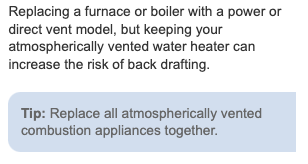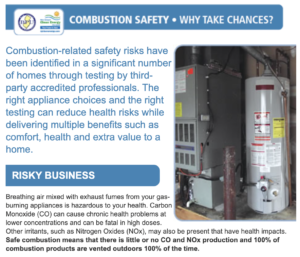Why Should You Replace Your “Atmospherically Vented” Water Heater?
“Atmospherically vented” water heaters with metal flue pipes raise a lot of combustion-related safety risks, including vulnerable appliances, pressure imbalance, back drafting etc.
Breathing air mixed with exhaust fumes from your gas-burning appliances is hazardous to your health. Carbon Monoxide (CO) can cause chronic health problems at lower concentrations and can be fatal in high doses. Other irritants, such as Nitrogen Oxides (NOx), may also be present that have health impacts. Safe combustion means that there is little or no CO and NOx production and 100% of combustion products are vented outdoors 100% of the time.
Common risks may include:
Vulnerable Appliances: Water heaters, boilers and furnaces, (and many fireplaces), are “atmospherically vented” appliances, which means these are the systems most at risk. Of particular concern is when boilers or furnaces are replaced and these older style (non-power-vented) water heaters are left behind.
Many gas ranges are unvented appliances, releasing 100% of their exhaust or combustion products back into the home. Range hoods that vent to the outside should be used whenever the stove or range is in use.
• Pressure imbalances. Gas mixes with indoor air to burn in an atmospherically vented water heater. When the system works as designed, very small pressure differences push exhaust products safely up the vent (left). However, exhaust fans, clothes dryers, leaky ductwork and wind can create negative pressures in the vicinity of the water heater. Flow through the vent can reverse, meaning exhaust fumes enter the home. This dangerous condition is known as “spillage” or “back drafting.”
Check out the video below showing theatrical fog used to simulate what a bath fan or kitchen range hood will do to atmospherically-vented combustion gases. Watch what happens when an exhaust fan is turned on about 12 seconds into the video, reversing the flow of the combustion gases, drawing them back into the house. (video credit to Carl Seville on website greenbuildingadvisor)
• Limited testing. Few combustion appliances are tested or adjusted for safe combustion after installation.
• Ineffective range hoods. Many homes with gas stoves have recirculating range hoods that don’t vent outdoors. If having a range hood installed or replaced, install a hood that vents to the outside.
House as a System
A house is a system that incorporates heating, cooling, air circulation and more. If the pieces don’t work well together, life-threatening problems could become a serious concern. In a high-performing home, a “whole-house” design approach and quality craftsmanship combine to deliver better comfort, healthier indoor air and energy cost savings in a package that’s built to last and hold its value for years to come.

Water heaters are the second highest source of energy usage in the home, but ENERGY STAR certified water heaters reduce up to 50% of energy usage. Oxford Energy chooses ENERGY STAR® certified products like The Rinnai Sensei tankless water heating system that provides endless hot water with much less energy consumption.
The information in this article provided by NJ Clean Energy Website. For more detailed information, see https://www.njcleanenergy.com/residential/programs/warmadvantage/combustion-safety

